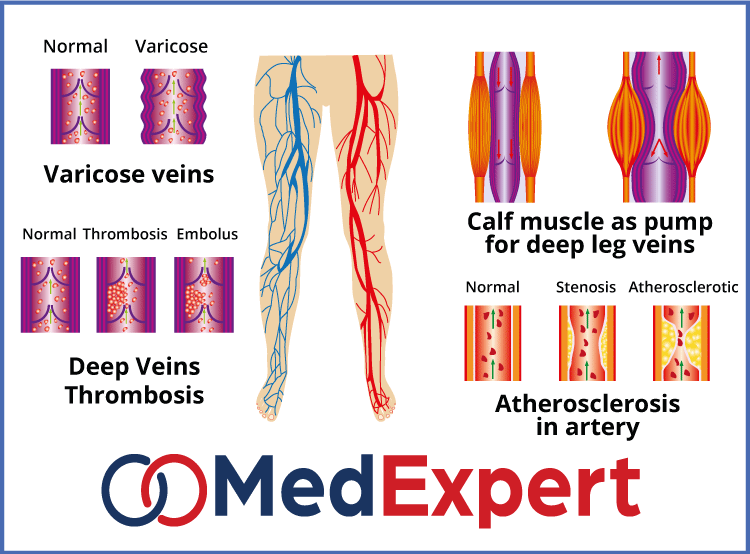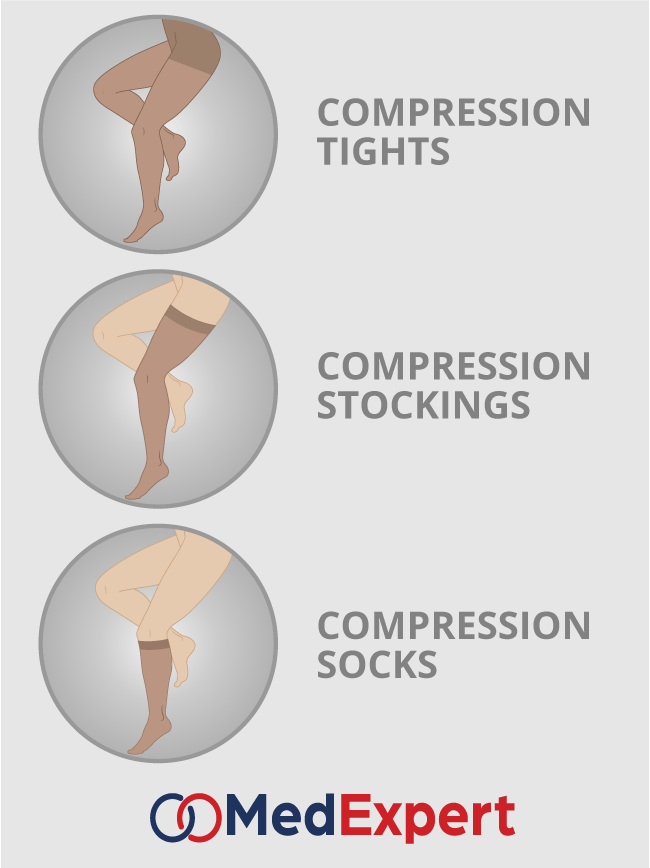Chronic Venous Insufficiency
Blood circulates through arteries from heart to other parts of the body and then is carried back to the heart through veins. If a venous wall or valves in leg veins are not working effectively, it becomes difficult for blood to return to the heart from the legs and occurs the condition called chronic venous insufficiency. CVI symptoms include swelling, aches, varicose veins, etc. Chronic venous insufficiency treatment depends on several factors and may involve both, conservative treatment methods and surgical procedures. Below we are going to review this condition in more details together with the symptoms it causes, diagnostics services and treatment options available for it.
The arteries are responsible for carrying blood from your heart out to the rest of your body. Your veins carry blood back to the heart and valves in the veins stop the blood from flowing backward. Venous insufficiency is when there is trouble sending blood from your limbs to the heart.When blood doesn’t flow back properly to the heart causes blood to pool in the veins in your legs.

This condition can be caused by several factors even though it’s most commonly caused by blood clots (deep vein thrombosis) and varicose veins.There are simple steps you can take to lower your chances of developing the condition even if you have a family history.
What causes Chronic Venous Insufficiency?
It is most often caused by either blood clots (previous cases) or varicose veins. When forward flow through the veins is obstructed like in the case of a blood clot, blood builds up below the clot can lead to venous insufficiency.
In varicose veins, the valves are often missing or impaired and causes blood to leak back through the damaged valves. Weakness in the leg muscles that squeeze blood forward can also contribute to venous insufficiency in some cases.
This condition is more prominent in women than in men. Other risk factors include:
- Blood clots
- Varicose veins
- Obesity
- Pregnancy
- Smoking
- Cancer
- Muscle weakness, leg injury, or trauma
- Swelling of a superficial vein (phlebitis)
- Family history of venous insufficiency
- Inactivity (sitting or standing for long periods of time without moving)
CVI SYMPTOMS
- Edema (swelling of the legs or ankles)
- Pain that worsens when you stand and gets better when you raise your legs
- Leg cramps
- Aching, throbbing, or a feeling of heaviness in your legs
- Itchy legs
- Weak legs
- Thickening of the skin on your legs or ankles
- Skin that is changing colour (especially around the ankles)
- Leg ulcers
- Varicose veins
- Feeling of tightness in your calves
CHRONIC VENOUS INSUFFICIENCY TREATMENT OPTIONS
The type of treatment will depend on a several factors including the reason for the condition and your health status and history. The other factors that your doctor will consider are:
- Specific symptoms
- Age
- Severity of your condition
- How well you can tolerate medications or procedures
Prescription-wear compression stockings is the most common treatment type. They apply pressure at the ankle and lower leg and help to improve blood flow and can reduce leg swelling. They come in a range of prescription strengths and different lengths. Your doctor will help you determine the best type of compression stocking is most suitable for your treatment.
Treatment for venous insufficiency can include several different strategies:
Improving Blood Flow
Some times to improve your blood flow include:
- Keeping your legs elevated whenever possible
- Wearing compression stockings
- Keeping your legs uncrossed when seated
- Exercising regularly

Medications
A number of medications that may help those suffering from this condition include:
- Diuretics: Draw extra fluid from your body through your kidneys
- Anticoagulants: Thin the blood
- Pentoxifylline (Trental): Improve blood flow
Surgery
More serious cases of venous insufficiency require surgery sometimes. One of the following surgeries may be suggested:
- Surgical repair of veins or valves
- Removing the damaged vein
- Minimally invasive endoscopic surgery
- Vein bypass
- Laser surgery
Ambulatory Phlebectomy
This outpatient procedure involves numbing certain spots on your leg, then making small incisions to remove smaller varicose veins.
Sclerotherapy
Normally reserved for advanced venous insufficiency where a chemical is injected into the damaged vein so that it is no longer able to carry blood. Blood will flow to the heart through other veins and the damaged vein will eventually be absorbed by the body. This method is used to destroy small to medium veins.
Catheter Procedures
A catheter procedure for larger veins is used in severe cases. They’ll insert a catheter (a thin tube) into the vein, heat the end of it and then remove it. The vein will close and seal from the heat as the catheter is taken out.
DIAGNOSING VENOUS INSUFFICIENCY
- History taking and physical exam: A physical examination and a complete medical history will be taken to figure out if you have venous insufficiency. Some imaging tests may also be ordered to pinpoint the source of the problem. They may include a venogram or a duplex ultrasound.
- Venogram: An intravenous (IV) contrast dye is injected into your veins. The blood vessels will appear opaque on the X-ray image which helps the doctor see them clearer.
- Duplex Ultrasound: To test the speed and direction of blood flow in the veins. Gel will be rubbed on your skin and then a press a small hand-held device (transducer) against your skin. Sound waves that bounce back to a computer produces the images of blood flow.


